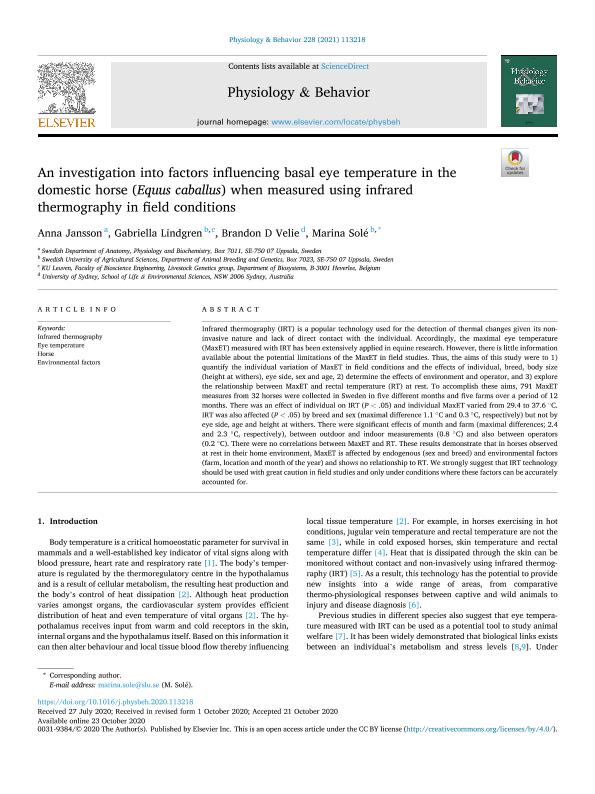Mostrar el registro sencillo del ítem
dc.contributor.author
Laseca, Nora

dc.contributor.author
Demyda Peyrás, Sebastián

dc.contributor.author
Valera Córdoba, Mercedes

dc.contributor.author
Ramón, Manuel
dc.contributor.author
Escribano, Begoña María
dc.contributor.author
Perdomo González, Davinia Isabel

dc.contributor.author
Molina, Antonio José
dc.date.available
2022-07-07T10:21:14Z
dc.date.issued
2022-03
dc.identifier.citation
Laseca, Nora; Demyda Peyrás, Sebastián; Valera Córdoba, Mercedes; Ramón, Manuel; Escribano, Begoña María; et al.; A genome-wide association study of mare fertility in the Pura Raza Español horse; Elsevier; Animal; 16; 3; 3-2022; 1-8
dc.identifier.issn
1751-7311
dc.identifier.uri
http://hdl.handle.net/11336/161517
dc.description.abstract
Despite the economic importance of fertility for the horse industry, few efforts have been made to achieve a better understanding of the genetic mechanisms underlying its control. This is probably due to the difficulty of obtaining reliable phenotypes and the complexity of modelling the environmental and management factors. This work is novel in that we propose to use reproductive efficiency (RE) as an indicator of mare fertility. To achieve this, we performed a genome-wide association study in the Pura Raza Español horse aimed at identifying genomic variants, regions, and candidate genes associated with fertility in mares. The dataset included 819 animals genotyped with the Affymetrix Axiom™ Equine 670 K single-nucleotide polymorphisms (SNPs) Genotyping Array and the deregressed breeding values for RE trait, obtained using a ssBLUP model, employed as pseudo-phenotypic data. Our results showed 28 SNPs potentially associated with RE, which explained 87.19% of the genetic variance and 6.61% of the phenotypic variance. Those results were further validated in BayesB, showing a correlation between observed and predicted RE of 0.57. In addition, 15 candidate genes (HTRA3, SPIRE1, APOE, ERCC1, FOXA3, NECTIN-2, KLC3, RSPH6A, PDPK1, MEIOB, PAQR4, NM3, PKD1, PRSS21, IFT140) previously related to fertility in mammals were associated with the markers and genomic regions significantly associated with RE. To our knowledge, this is the first genome-wide association study performed on mare fertility.
dc.format
application/pdf
dc.language.iso
eng
dc.publisher
Elsevier

dc.rights
info:eu-repo/semantics/openAccess
dc.rights.uri
https://creativecommons.org/licenses/by-nc-nd/2.5/ar/
dc.subject
ASSOCIATION ANALYSIS
dc.subject
CANDIDATE GENES
dc.subject
EQUINE
dc.subject
REPRODUCTIVE TRAITS
dc.subject
SINGLE-NUCLEOTIDE POLYMORPHISMS
dc.subject.classification
Tecnología GM, clonación de ganado, selección asistida, diagnósticos, tecnología de producción de biomasa, etc.

dc.subject.classification
Biotecnología Agropecuaria

dc.subject.classification
CIENCIAS AGRÍCOLAS

dc.title
A genome-wide association study of mare fertility in the Pura Raza Español horse
dc.type
info:eu-repo/semantics/article
dc.type
info:ar-repo/semantics/artículo
dc.type
info:eu-repo/semantics/publishedVersion
dc.date.updated
2022-06-30T19:03:06Z
dc.journal.volume
16
dc.journal.number
3
dc.journal.pagination
1-8
dc.journal.pais
Países Bajos

dc.description.fil
Fil: Laseca, Nora. Universidad de Córdoba; España
dc.description.fil
Fil: Demyda Peyrás, Sebastián. Consejo Nacional de Investigaciones Científicas y Técnicas; Argentina
dc.description.fil
Fil: Valera Córdoba, Mercedes. Universidad de Sevilla; España
dc.description.fil
Fil: Ramón, Manuel. Centro Regional de Selección y Reproducción Animal; España
dc.description.fil
Fil: Escribano, Begoña María. Universidad de Córdoba; España
dc.description.fil
Fil: Perdomo González, Davinia Isabel. Universidad de Sevilla; España
dc.description.fil
Fil: Molina, Antonio José. Universidad de Córdoba; España
dc.journal.title
Animal

dc.relation.alternativeid
info:eu-repo/semantics/altIdentifier/url/https://linkinghub.elsevier.com/retrieve/pii/S1751731122000234
dc.relation.alternativeid
info:eu-repo/semantics/altIdentifier/doi/http://dx.doi.org/10.1016/j.animal.2022.100476
Archivos asociados
